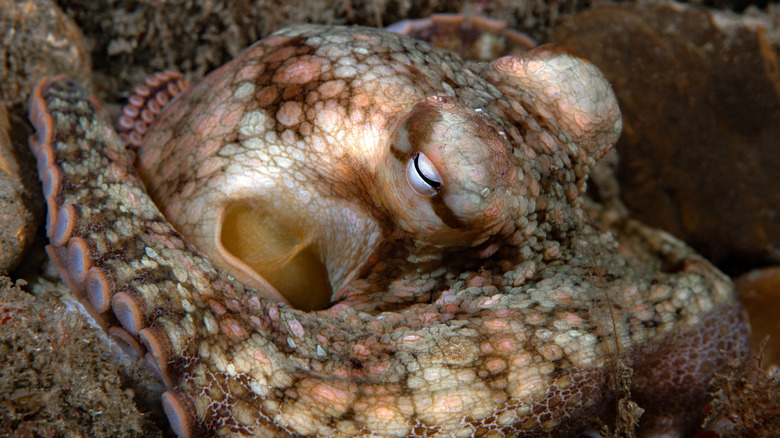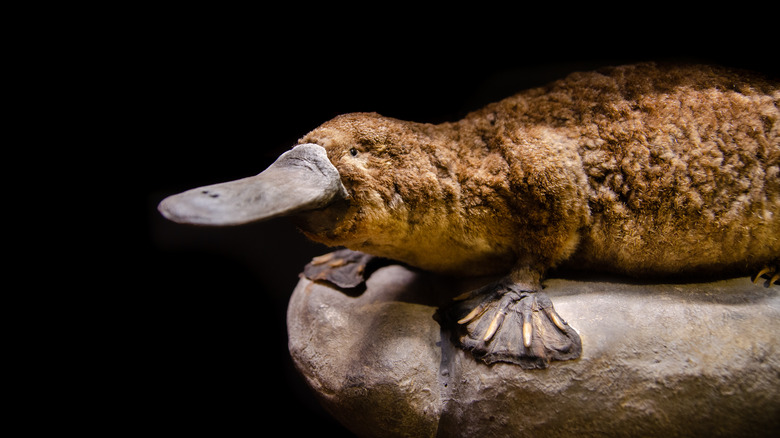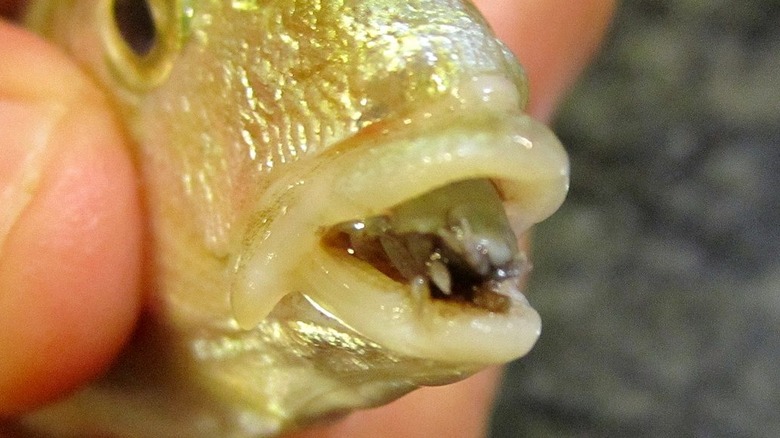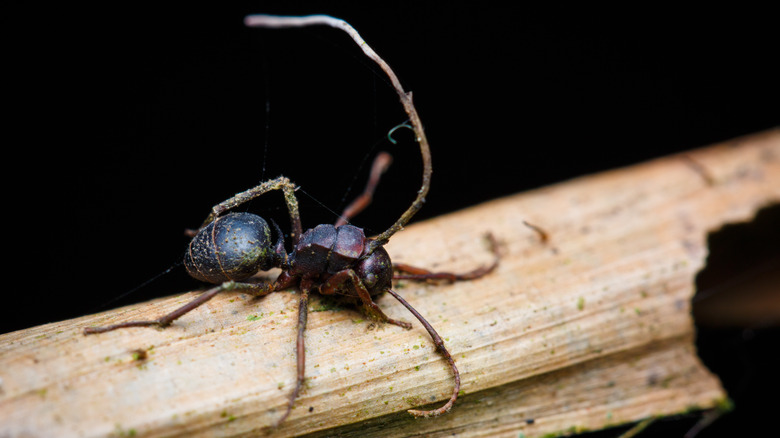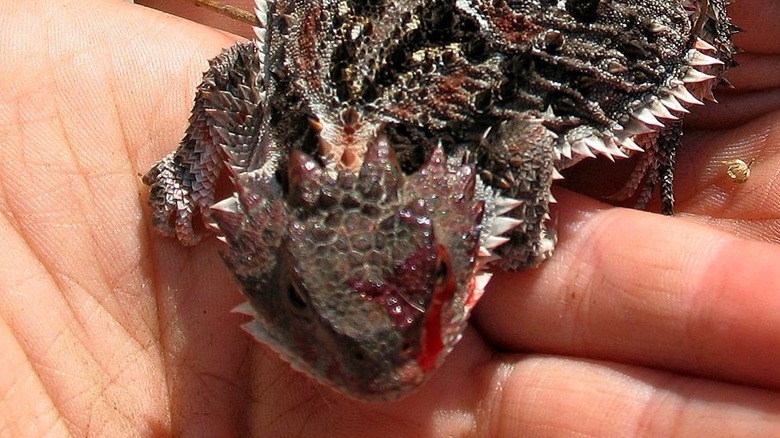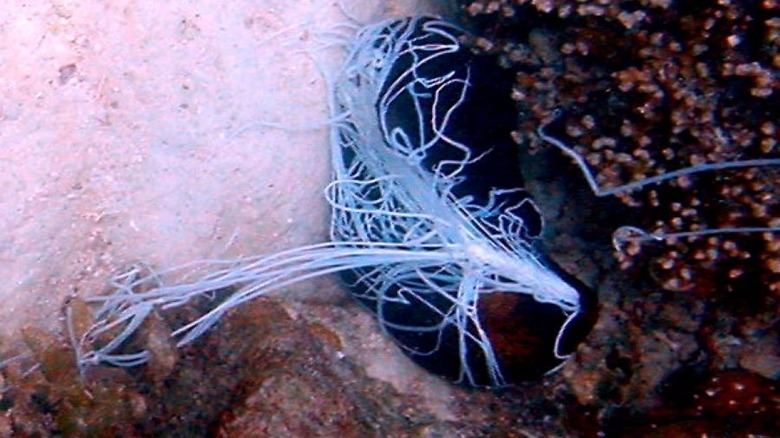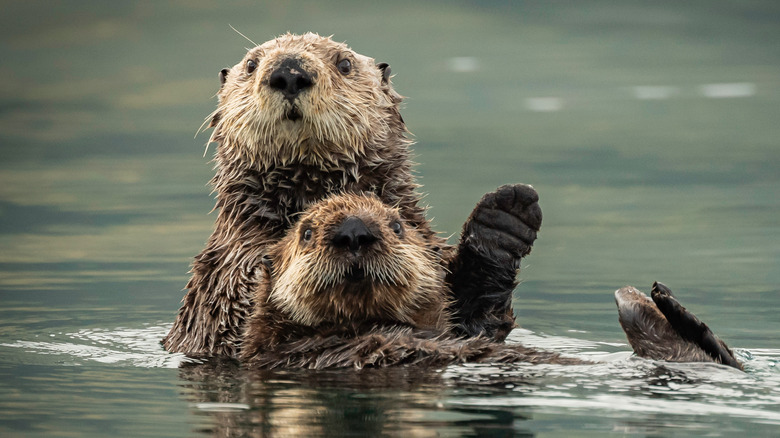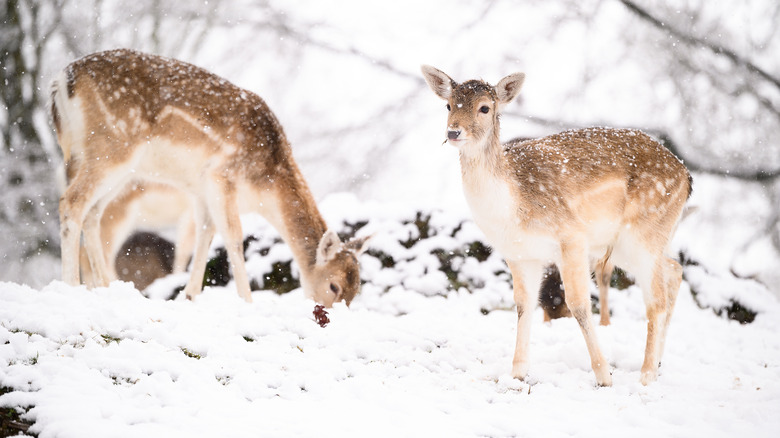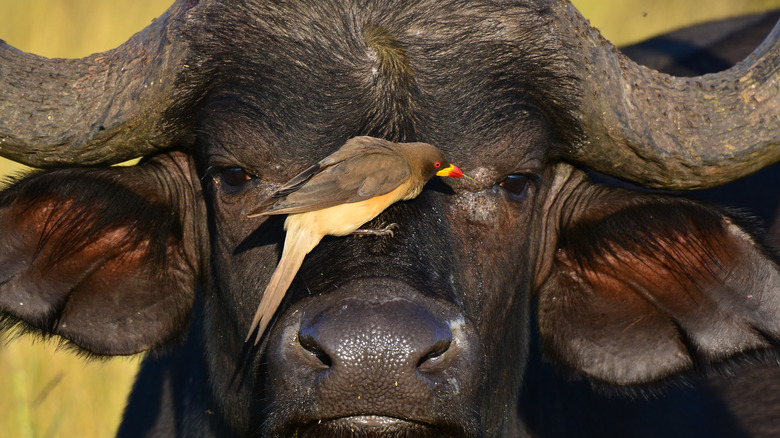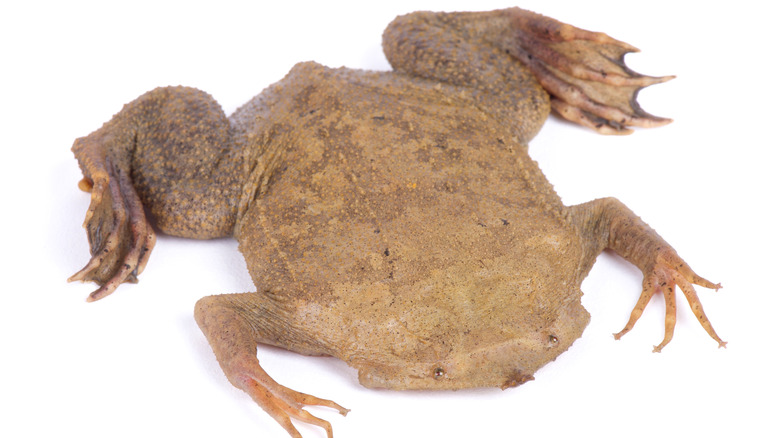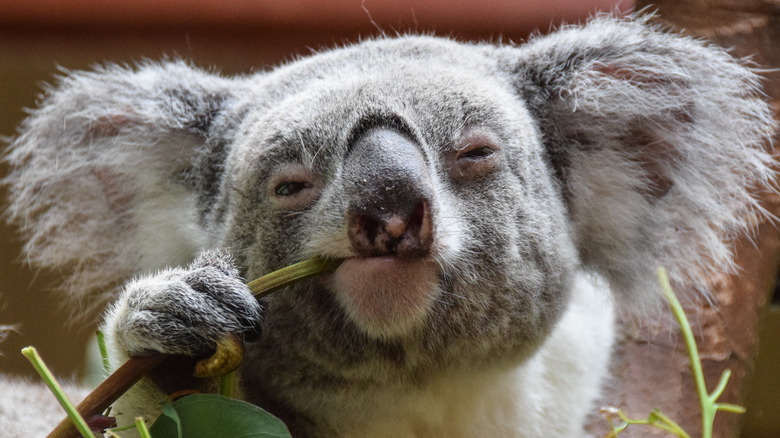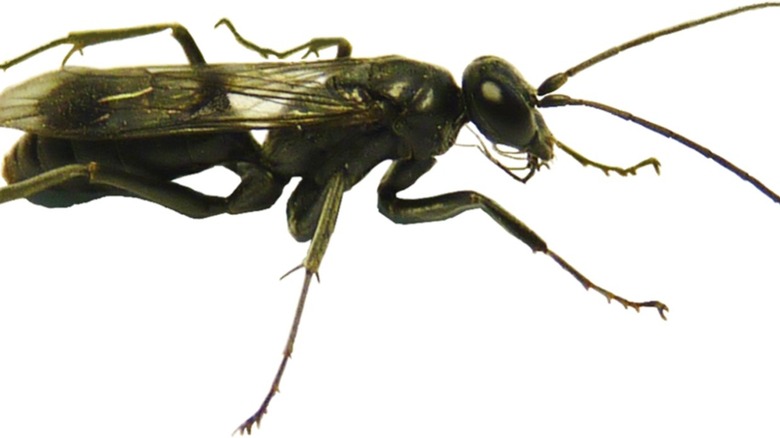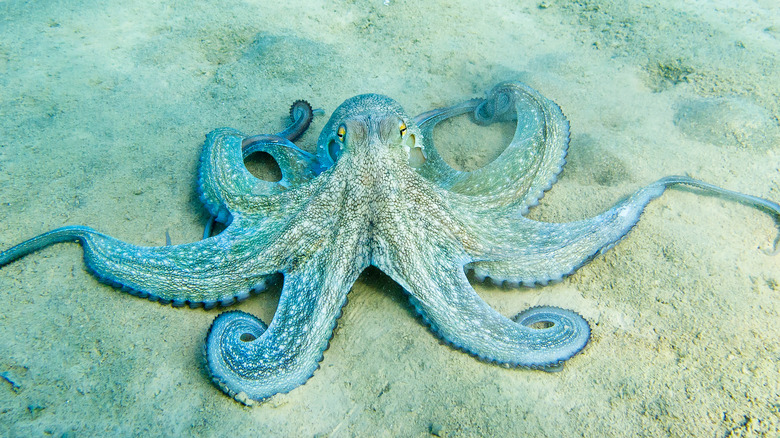Creepy Facts About Animals That Will Keep You Up At Night
Scientists estimate that there are about 8.7 million different species on Earth, roughly 89% of which are animals (via Science Daily). They've only cataloged around a million of them, which means there are plenty more for us to discover (if they don't end up dying due to man-made climate change, that is).
Not everything is known about all the species that have been identified, but some of the things that have been discovered are fascinating. For instance, ostriches kick hard enough to kill humans, frogs drink through their skin and not their mouths, and some jellyfish can sting even after they're dead.
However, along with these interesting facts and impressive feats come some truly bizarre behaviors — the kind that might even make you lose sleep. From surprising self-defense secrets to repulsive reproductive rituals, here are some creepy facts about animals that will keep you up at night.
Some mammals glow under ultraviolet light
The platypus is an odd creature: it looks like the hairy lovechild of a duck and a beaver, it's a mammal that lays eggs instead of giving live birth, and it has a single orifice for both reproductive and excretory purposes (via FlipScience). It's one of only five living species of monotremes, a peculiar animal group that, alongside a few separate Australian mammals, has a recently revealed unique trait: the ability to glow in the dark under ultraviolet (UV) light.
In a 2020 paper, researchers wrote about how platypus specimens in museums demonstrated biofluorescence (which is when an organism absorbs short-wavelength light, like UV light, and emits longer wavelengths or glows in the dark). According to CNET, this study inspired scientists at the Western Australian Museum to grab some UV lights and see if any of the 800 other mammalian species in their collection had the same ability. Long story short, their tests yielded glowing results.
In an interview with ABC News, curator Kenny Travouillon shared that a wide assortment of Australian mammals, including marsupial moles, bilbies, wombats, and echidnas, glowed under UV light. While experts still haven't figured out the purpose of the biofluorescence, they think it's to help the animals see each other at night.
One parasite eats and permanently replaces fish tongues
Can you imagine waking up one day, looking in the mirror, and seeing that your tongue had been eaten and replaced by a sinister-looking parasite? That's exactly what the tongue-eating louse does to fishes. According to Wired, this icky isopod enters through the fish's gills, chows down on the victim's tongue, and then firmly plants itself there and becomes a perfectly functional replacement. This is the first and possibly only known case of a parasite becoming a working replacement of its host's organ in the animal world, according to a 1983 paper. But it gets worse.
In at least one species of tongue-eating louse from Florida, Colt William Cook observed that the parasite is born male, turning female only after it pulls off its tongue-terminating trick. Upon successfully replacing its host's organ, it mates with one of the other parasites that managed to enter via the fish's gills. Their brood of all-male offspring then aggressively search for their own victims (the same species of fish), beginning the process once again when they find their target.
Scientists aren't sure how many of these horrifying creatures are out there. Given that a single study conducted in India yielded 10 new species, this parasite's actual species diversity could be great enough to leave scientists tongue-tied.
Ants turn into zombies via a mind-controlling fungus
Thanks to popular culture, zombies are thought to be mindless, shambling undead who were infected through bites and wounds and who are driven only by the urge to eat brains and flesh. In the case of zombified carpenter ants, there's something far more sinister behind the transformation: Ophiocordyceps, a parasitic, mind-controlling fungus that, according to LiveScience, specifically targets their species.
The Atlantic details this devious parasite's meticulous methodology. After the fungus enters the carpenter ant's body, it takes about seven days for the parasite to sap its unfortunate host of nutrients. It makes its way up to the ant's brain, taking control of it like a nightmarish science fiction movie made real. Entomologist David Hughes believes that this process kills the ant's neurons while releasing the fungus' muscle-contracting chemicals, allowing the parasite to control the hapless host like a meat puppet.
At this point, the fungus forces the ant to find a leaf that's exactly 25 centimeters (just under 10 inches) from the ground — the elevation at which the temperature and humidity are well-suited for the parasite to thrive — and commands the insect to bite down hard. As the zombified ant remains suspended above ground, a fungal stalk grows out of its head. The stalk produces spores that will eventually fall down and infect other carpenter ants unlucky enough to crawl under it.
Horned lizards squirt blood from their eyes
One would think that the horned lizard's spiky exterior would be more than enough to dissuade carnivores from nibbling on it, but this North American reptile employs a host of additional defensive traits (including camouflage and self-inflation) to survive. Its most infamous ability is its blood-squirting eyes: think Cyclops of the X-Men, but with horrifying streams of hemoglobin-rich liquid instead of concussive force beams.
When the horned lizard senses danger, it contracts the muscles near the major veins surrounding its eye (via Ask Nature). This allows blood to rapidly fill the reptile's ocular sinuses while restricting cardiac blood flow. Eventually, the pressure build-up will rupture the sinus membranes. When this happens, the lizard auto-hemorrhages, meaning its eye socket ejects the accumulated blood forcefully. Experts have observed the jet stream of blood reaching as far as 4 feet. Even more impressive is how the reptile can reportedly do this as frequently as needed within a short time frame, for reasons that scientists still can't fully explain.
Fortunately, according to a 2001 paper, horned lizards are unlikely to blast humans with their blood. They reserve this special move for canids and felids, typically aiming for their mouths (via BBC). Apparently, this can be extremely unpleasant for the cats and dogs on the receiving end. Experts think that horned lizards' appetite for venomous harvester ants imbues their blood with a chemical that's particularly foul-tasting.
Sea cucumbers shoot their own organs at would-be threats
If you could pick your own special biological self-defense measure, it's a safe bet that squirting your intestines at your foes wouldn't be very high on your list. This gross-sounding ability is similar to what certain species of sea cucumbers possess, and it's surprisingly effective at deterring sea turtles, sea stars, crabs, and other potential predators.
Through a process called evisceration, this gutsy move involves the expulsion of some or all of the sea cucumber's internal organs, as explained in a 2019 paper in Zoological Letters. There are two ways the echinoderm can squirt out its own guts: either through its mouth or through its back end. According to marine biologist Christopher Mah, this defensive action is made possible by the sea cucumber's ability to soften or toughen its body texture when it wants to (just like other echinoderms). It's a straightforward procedure: First, the ligaments and tissues that link and anchor the sea cucumber's internal organs soften, followed by the opening through which they'll exit. Finally, the sea cucumber's muscles contract, shooting its guts straight out. Any threats in the echinoderm's vicinity would start gobbling up the organ offerings, allowing the now-literally gutless creature to slip away.
The sea cucumber's incredible regenerative abilities allow it to grow back its organs (though it takes a week to about five months to accomplish this).
Adorable aquatic animals engage in violent sex (and necrophilia)
If you've ever seen photos of sea otters holding hands as they float on the water, it's hard not to find these marine mammals endearing. Unfortunately, sea otters can also exhibit some pretty brutal behavior. For starters, male sea otters have been known to assault and even kill seal pups. A 2010 paper talked about 19 cases, including a particularly gruesome instance where a sea otter bit a pup's face, held it underwater, and copulated with it for over an hour until it died. Female sea otters don't seem to fare much better under the males' vicious reproductive strategies. An article on Vox cited veterinarian Heather Harris, who shared two reports (observed 10 months apart) of male sea otters forcefully copulating with female sea otter carcasses, and also says that one sea otter off the coast of Canada apparently assaulted and murdered a dog.
Another favorite marine mammal, the dolphin, exhibits similarly vicious and violent reproductive approaches. According to the Atlantic, sexual coercion is a part of their strategy, with gangs of male dolphins aggressively corralling a single female for the purpose of forced copulation. Oh, and this cetacean also commits infanticide: Males have been observed to kill dolphin calves, with the possible goal of adding mother dolphins, now free from the responsibility of caring for their young, to the pool of available mates (via BBC).
Deer eat meat (and even human remains)
Imagine Bambi prancing around merrily in the forest, frolicking with his animal buddies. Suddenly, they hear the adorable white-tailed deer's stomach grumble, causing all of them to stop and giggle. Aware of his own hunger, Bambi turns to one of the little birds hopping in the grass around him... and nabs it with his jaws in one swift motion. Humor quickly turns into horror as Bambi proceeds to eat his friend, and the rest of the forest crew start running for their lives. While Disney likely wouldn't greenlight such a movie, the scenario isn't actually that farfetched.
National Geographic lists alfalfa, fruits, nuts, twigs, and fungi as part of the typical white-tailed deer diet. However, such a limited menu can lead to nutrient deficiencies, including lack of calcium, phosphorus, and sodium, particularly during the winter. Thus, experts have observed these hoofed mammals occasionally addressing their nutritional gaps by eating birds, fish, and even the corpses of rodents and rabbits (via the Independent).
That might not be so surprising, but deers have even been spotted chewing on human remains. In 2015, researchers witnessed a deer stumbling upon a decomposing body that had been left in the open for about half a year. The scavenging ruminant was photographed snacking on the corpse.
Oxpeckers drink the blood of their hosts
When it comes to mutually beneficial associations in the animal kingdom, few are as iconic as the way megafauna and oxpeckers work together. Rhinos, giraffes, oxen, hippos, and other large mammals benefit from the oxpecker's persistent pecking. Their ticks, dead skin, and bodily secretions serve as a buffet for the tiny bird. There's a darker side to this symbiotic relationship, though, with some evidence that in certain cases, the oxpecker actually does its host more harm than good.
According to a paper published in 2000, researchers have assumed for years that the oxpecker's presence greatly reduces its host's tick load. However, field tests in Zimbabwe revealed that shooing away the birds didn't really have much of an impact on how many ticks their prospective hosts had. Worse, oxpeckers have a tendency to eat just about anything they can get from their host's skin, including blood from open wounds. The research showed that because of their incessant blood-drinking, oxpeckers actually made the healing time of their wounded hosts considerably longer. Authors of a 2010 study noted that oxpeckers' relationships with their hosts are "generally mutualistic," albeit with certain opportunistic "parasitic behaviors."
Still, experts know that oxpeckers have helped save at least one critically endangered species. Based on findings from a 2020 paper in Current Biology, oxpeckers' hissing calls helped black rhinos evade would-be hunters up to 50% of the time. As black rhinos can't see very well, the birds are a useful warning system.
This toad mama can trigger your trypophobia
If the idea of circular things embedded on a creature's back makes you extremely uneasy, you may want to skip to the next entry.
Meet the Surinam toad, an amphibian that's easily recognizable for two reasons. One, it's flat-bodied to an almost ridiculous degree; in fact, it can easily pass for roadkill, even in the eyes of herpetologists (via Wired). This strange shape works to the toad's advantage — it's a suction feeder that lunges toward and sucks in passing prey, and so likes to blend in at the bottom of ponds where its camouflage skills allow it to surprise its unsuspecting meals.
The Surinam toad's second strange trait — and the one that's likely to give you the heebie-jeebies — is its ability to store and hatch around 60 to 100 eggs (via the San Diego Zoo) on its back. This honeycomb-like formation serves as individual wombs for the tiny froglets. Instead of spending time swimming around as tadpoles, they grow for four months in their mother's back, safe from any threats and predators (via National Geographic).
Koalas have human-like fingerprints (and are kind of disgusting)
If you placed human fingerprints next to a koala's, even a forensic print analyst would have trouble telling man from marsupial. As LiveScience explains, koala fingerprints look remarkably human. While it's not surprising that chimpanzees and gorillas have fingerprints, the fact that primates and koalas' forebears started evolving separately in the Cretaceous period makes it weird for these eucalyptus-munching marsupials to have human-like fingerprints. Experts aren't completely sure what koalas' fingerprints are for, especially since most of their close mammalian relatives don't have them. However, the popular theory is that their fingerprints help them get a better grip of eucalyptus tree branches.
It's amazing just how much koalas have adjusted to their diet over hundreds of thousands of years. Eucalyptus leaves don't have much caloric value, so the koala spends only about two hours a day awake (via National Geographic). Additionally, eucalyptus leaves are too toxic for other animals to eat, but koalas' bodies are capable of quickly expelling the toxins. And how do they develop this useful ability, you ask? Why, by eating their mothers' fecal matter, of course! For a few weeks of their development, koala young (joeys) consume their mom's anal discharge: a mix of solid fecal matter and a protein-rich, gut-bacteria-filled substance called pap (via PBS NOVA).
Oh, and try not to get peed on by a koala, because you can get the koala version of chlamydia that way.
This wasp stuffs its nest with spiders (and sometimes ants)
Discovered in China's Jiangxi Province, the spider-eating bone-house wasp is somehow even more horrifying than its name suggests. As Wired reports, adults of this species don't really eat spiders and actually prefer nectar and pollen. Instead, they catch spiders to feed their larvae.
Before laying an egg, the wasp mom flies off to find some eight-legged baby food. Upon finding an arachnid target, she stings it with powerful venom that paralyzes but doesn't kill it. She then puts the incapacitated spider in her nest and lays her egg. Thus, by the time the young one hatches, a big, still-breathing buffet is already waiting for it (via ABC News).
Researchers found other interesting surprises in the nests they studied. In some of them, the entry compartments were lined with the bodies of "aggressive, large-bodied" ants, according to a 2014 paper. This technique (called anting) isn't exactly unique, though. Other animals, including some birds, use the scent of ants' corpses to put off potential threats and parasites from their homes.
Octopuses are shockingly smart (and quite creepy)
A century ago, England's Brighton Aquarium had a disappearing fish problem. Custodians noticed that they were losing lumpfish at a seemingly steady rate. After a few days (and a few more lost lumpfish), they discovered the culprit: an octopus. The crafty cephalopod had realized it could sneak out at night, grab a quick snack from the lumpfish tank, and crawl right back into its own tank, with no one the wiser (via Scientific American).
Over the years, captive octopuses have demonstrated a surprising level of cognitive ability. In 2009, a two-spotted octopus at California's Santa Monica Pier Aquarium apparently figured out how to take apart a water recycling valve. This resulted in a 200-gallon-flood of seawater all over the flooring, the LA Times reported. There have also been numerous accounts of octopuses in captivity learning how to use light bulbs for target practice, causing their aquariums to overflow, and even shooting water at people they recognize, according to the Washington Post.
According to experts, the secret to octopus intelligence likely lies in the abundance of neurons in their tentacles. This enables them to have exceptional control and sensitivity, a necessity for an organism with such a complicated, unwieldy body to operate (via the Guardian). This, combined with their incredible malleability, makes octopuses top-tier escape artists — and possibly far more intelligent than many of us realize.
